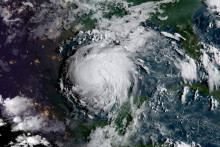The consequences of Hurricane Harvey are unprecedented. What makes this tropical storm so powerful?
‘Hurricanes are of course nothing special, they are typical for tropical and semi-tropical areas. The U.S. have experienced several very severe hurricanes – Katrina, Sandy and now Harvey. Harvey is not special because of its power, but because of the amount of water it brought. The precipitation has been extremely high and the hurricane is also moving very slowly, lingering over Houston. Meteorologists address a lack of wind in the upper atmosphere as the reason why Harvey is so slow above land. It is estimated that the hurricane might be coming back to Houston now, in which case the worst is indeed still to come.’
Was the hurricane and its consequences partly caused by climate change?
‘We know that the frequency of hurricanes has been continuously increasing. The amount of precipitation (like rain, snow and hail) also increases. And yes, most scientists believe there is a clear link between this pattern and climate change. There are clear indications hurricanes will become even more frequent in the future – and the more precipitation, the more trouble. That’s no news, of course.’
Could have some of the hurricane’s consequences been prevented?
‘This isn’t the first hurricane to hit the United States. Katrina hit New Orleans twelve years ago. Afterwards, many people from New Orleans actually relocated to Houston. Now we are twelve years later, so you’d expect there was enough time to take precautions. Some consequences of Harvey could have been prevented, but actions needed to be taken. There were many ambitious plans after Katrina, but they weren’t implemented. Many experts and politicians realized something needed to be done, but in Houston no big countermeasures were taken – they actually kept on building in the lowest areas of Houston - and now they expect the damage in Houston will be as high as it was after Katrina.’

What are some of the things that could have been done to prevent the current disaster in Houston?
‘They could have thought about where to temporarily store water during a hurricane. We need a system to store water and prevent it from flowing downwards towards the low-lying areas. For this, you can use spaces directly in the city, such as sports fields, carparks or city parks – all of these spaces can serve as a temporary water storage and be flooded if needed. We have similar infrastructure in the Netherlands, although we are also still in the process of becoming more resilient. We are still not fully prepared, but we are taking actions.’
Could a flood of this magnitude also happen in the Netherlands, here in Twente for example?
‘Only about a week ago I was having dinner with colleagues in Hengelo. It was raining hard for an hour and when we came outside there was about twenty centimeters of water all over the street. What if it rained for six hours instead? Yes, big floods here are not unthinkable. However, we already have some measures in place, such as the Kristalbad between Enschede and Hengelo, which could also be used as a temporary storage of water.’
The University of Twente is known for its expertise on water management. What is the UT doing to help prevent floods?
‘Just one of the examples is our transatlantic cooperation with the Stevens Institute of Technology in Hoboken, which started largely because of Hurricane Sandy. During this hurricane, parts of New Jersey and New York were flooded. This joined project aims to create more resilient cities that are able to recover from such disasters. Besides that, the Water Engineering & Management group is working on research on better water management of rivers and both the ET and the BMS faculty are involved in the Lumbricus program. This program aims to develop a ground and water system in the high sand grounds of the East and South of the Netherlands, where climate change is increasingly causing problems. In short, it aims to restore agricultural fields into more natural soil conditions, so they can also store more water. As you can see, there are many things we can do to prevent floods and these include also more sophisticated solutions than just building dams.’







